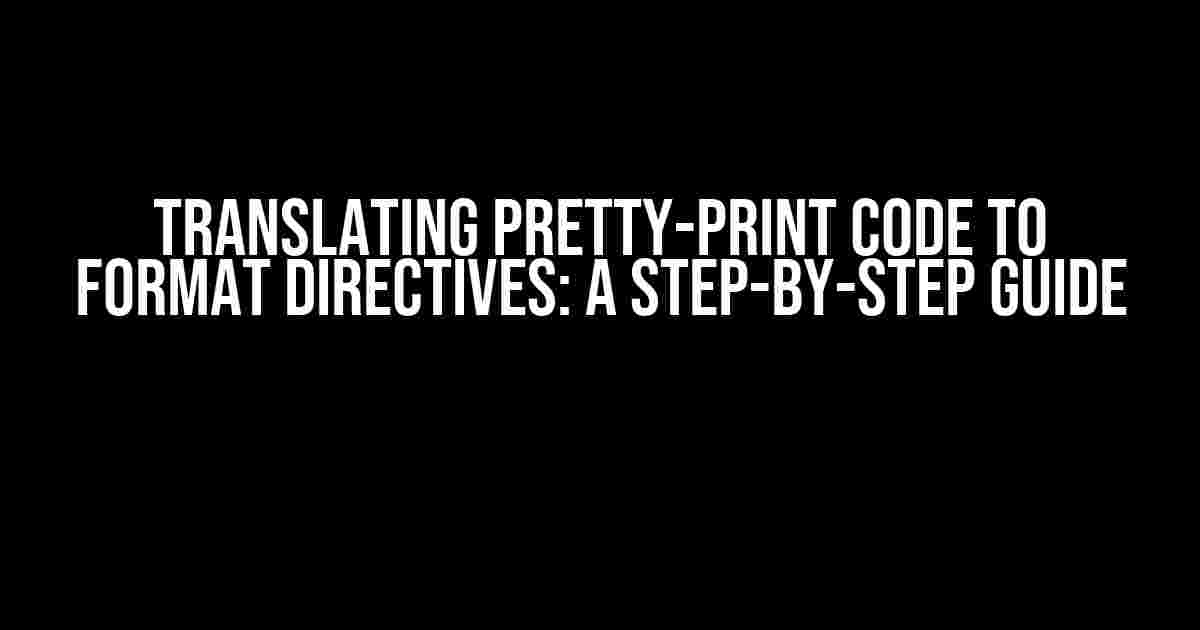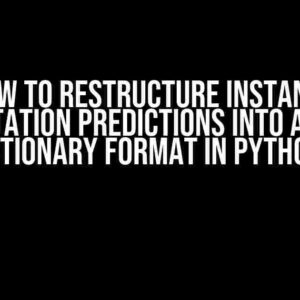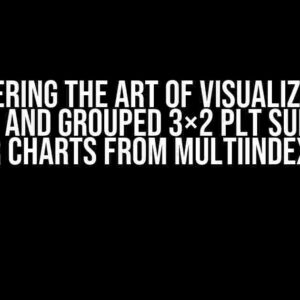Welcome to the world of code formatting! As a developer, you know how crucial it is to have clean, readable code that’s easy to maintain and understand. Today, we’re going to explore the fascinating realm of translating pretty-print code to format directives. Buckle up, because we’re about to embark on a thrilling adventure!
What is Pretty-Print Code?
Pretty-print code, also known as pretty printing, is the process of formatting source code in a way that makes it easy to read and understand. It involves rearranging the code’s structure, indenting, and spacing to create a visually appealing and organized layout. Pretty-print code is essential for collaborative coding, code reviews, and debugging.
Why Do We Need Format Directives?
Format directives are a set of instructions that guide the formatting process, ensuring that the code meets specific standards and conventions. They provide a common language for developers to communicate and agree upon the formatting rules, making it easier to work together on projects. Format directives also help in:
- Improving code readability and maintainability
- Enhancing collaboration and communication among team members
- Reducing errors and bugs caused by inconsistent formatting
- Streamlining code reviews and debugging processes
Translating Pretty-Print Code to Format Directives
Now that we’ve established the importance of pretty-print code and format directives, let’s dive into the translation process. We’ll use a real-world example to demonstrate how to convert pretty-print code into format directives.
Step 1: Identify the Formatting Rules
Take a closer look at the pretty-print code and identify the formatting rules used. Are the lines indented with spaces or tabs? Are there blank lines separating functions or logical blocks? Are the parentheses and brackets aligned? Make a mental note of these rules, as we’ll use them to create our format directives.
// Pretty-print code example
function calculateSum(a, b) {
let sum = a + b;
return sum;
}
Step 2: Break Down the Code Structure
Dissect the code into its constituent parts, such as functions, loops, conditional statements, and arrays. This will help us create format directives that target specific elements of the code.
// Broken down code structure
function declaration: calculateSum(a, b)
function body:
variable declaration: let sum = a + b;
return statement: return sum;
Step 3: Create Format Directives
Using the formatting rules and broken-down code structure, we can start creating format directives. These directives will guide the formatting process, ensuring that the code meets our desired standards.
| Format Directive | Description |
|---|---|
| indent_size = 4 | Indent using 4 spaces. |
| brace_style = allman | Use the Allman style for brace placement. |
| keep_empty_lines_at_eof = 1 | Leave one blank line at the end of the file. |
Step 4: Apply Format Directives
Now that we have our format directives, it’s time to apply them to the pretty-print code. We can use tools like Prettier, ESLint, or clang-format to enforce these directives and transform the code into a beautifully formatted masterpiece.
// Translated code with format directives applied
function calculateSum(a, b) {
let sum = a + b;
return sum;
}
Tips and Tricks
To get the most out of translating pretty-print code to format directives, keep the following tips and tricks in mind:
-
Be consistent: Establish a consistent formatting style throughout the project to ensure readability and maintainability.
-
Use tools wisely: Leverage formatting tools to enforce format directives and save time.
-
Communicate with your team: Share format directives with your team to ensure everyone is on the same page.
-
Review and refine: Regularly review and refine your format directives to adapt to changing project needs.
Conclusion
Translating pretty-print code to format directives is a crucial step in maintaining clean, readable, and collaborative codebases. By following the steps outlined in this guide, you’ll be well on your way to creating format directives that ensure your code meets the highest standards. Remember to stay consistent, use tools wisely, communicate with your team, and review and refine your format directives regularly. Happy coding!
As you embark on this formatting adventure, keep in mind that the art of translating pretty-print code to format directives is a continuous process. Stay curious, stay creative, and above all, stay formatted!
Happy coding!
Frequently Asked Question
Get your code in shape with these frequently asked questions about translating pretty-print code to format directives!
Q1: What is pretty-print code and why do I need to translate it to format directives?
Pretty-print code is a way to display code in a human-readable format, making it easier to understand and debug. However, when it comes to formatting code for output, you need to translate it to format directives to ensure consistency and readability. Think of it like dressing up your code for a night out – you want to make a good impression!
Q2: How do I identify the elements of pretty-print code that need to be translated?
Scan your code for elements like indentation, line breaks, and whitespace. These are the secret ingredients that make your code look neat and tidy, but can be tricky to translate to format directives. Take note of these elements and get ready to convert them into formatting magic!
Q3: What are some common format directives used in translating pretty-print code?
Some popular format directives include `%s` for strings, `%d` for decimal numbers, and `%x` for hexadecimal numbers. Think of them as a special set of instructions that tell your code how to dress up for the output party. Familiarize yourself with these directives and you’ll be translating like a pro in no time!
Q4: Can I use pretty-print code and format directives together?
Yes, you can! In fact, combining pretty-print code with format directives can create a powerful and flexible formatting system. Just be sure to keep your pretty-print code organized and your format directives concise, and you’ll be coding like a rockstar in no time!
Q5: What are some best practices for translating pretty-print code to format directives?
Some top tips include keeping your formatting consistent, using descriptive variable names, and testing your output to ensure it looks fabulous. Remember, translating pretty-print code to format directives is an art – take your time, be patient, and don’t be afraid to get creative!



